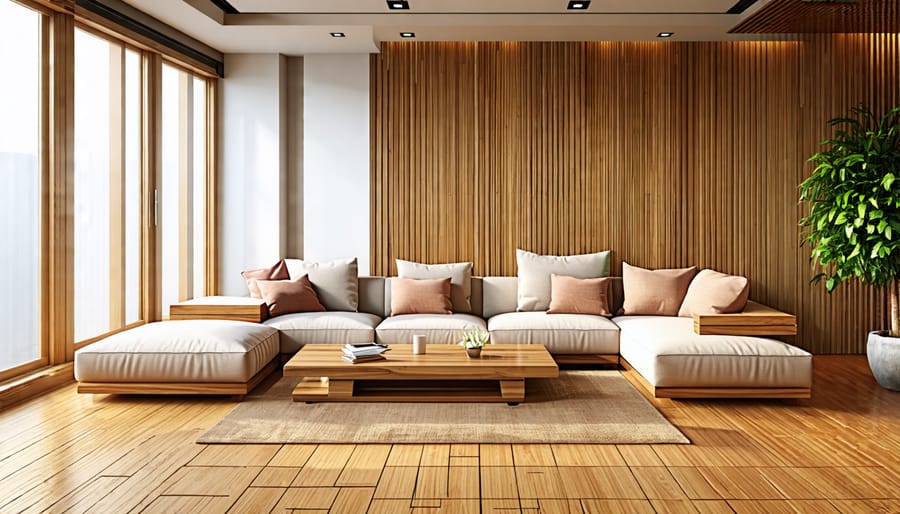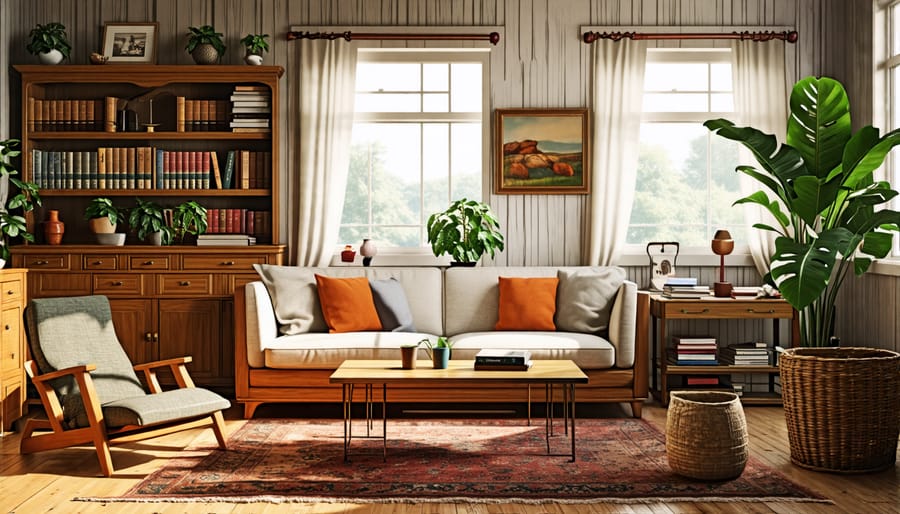Embrace sustainable design with eco-friendly materials that reduce your environmental impact without sacrificing style. Cork flooring offers a renewable, biodegradable option with excellent insulation properties and a unique, textured look. Bamboo, another rapidly renewable resource, provides a durable and attractive alternative to hardwood for flooring, furniture, and accents. Opt for low-VOC paints and finishes to improve indoor air quality and minimize harmful emissions during application and curing. Incorporate reclaimed wood, recycled glass, and organic fabrics like cotton, linen, and wool to create a chic, earth-conscious space that reflects your values and aesthetic.
Flooring Options
Bamboo
Bamboo flooring is an excellent sustainable option for your home. As a fast-growing grass, bamboo is highly renewable and can be harvested without damaging the plant’s root system. It offers a durable, long-lasting surface that resists wear and tear, making it perfect for high-traffic areas. Bamboo’s natural resistance to moisture and insects also contributes to its longevity. When selecting bamboo flooring, consider the different styles available, such as horizontal, vertical, or strand-woven, each with its own unique appearance. Keep in mind that bamboo can be prone to scratches, so it’s essential to maintain it properly with regular sweeping and gentle cleaning. Additionally, be aware that some bamboo flooring may be processed with adhesives containing volatile organic compounds (VOCs), so choose products labeled as low-VOC or VOC-free for improved indoor air quality. With its warmth, beauty, and eco-friendly properties, bamboo flooring is a smart choice for sustainable interior design.

Cork
Cork flooring is an excellent eco-friendly option for your home, offering a unique blend of style and sustainability. Made from the bark of cork oak trees, this renewable material is harvested every nine years without harming the tree. Cork flooring is naturally resistant to moisture, mold, and mildew, making it a hypoallergenic choice for healthier indoor air quality. It also provides effective insulation, helping to regulate room temperature and reduce energy costs.
One of the main advantages of cork flooring is its comfort underfoot. The material’s inherent softness and springiness make it gentle on joints, reducing fatigue and strain. However, this softness also makes cork more susceptible to dents and scratches from heavy furniture or sharp objects. Proper maintenance, such as using felt pads on furniture legs and trimming pet claws, can help minimize damage. While cork flooring is relatively durable, it may require refinishing every few years to maintain its appearance.
Reclaimed Wood
Reclaimed wood flooring adds a touch of rustic charm while promoting sustainability in your home. By repurposing old wood from barns, warehouses, or other structures, you give new life to materials that would otherwise end up in landfills. Each plank tells a story, with its unique markings, knots, and patina. Reclaimed wood is often harder and more durable than new wood due to the older trees it comes from. It’s an eco-friendly choice that reduces the demand for virgin timber. With proper installation and finishing, reclaimed wood floors can last for generations, adding character and warmth to your space.
Wall Coverings and Paint

Low-VOC and Zero-VOC Paint
VOCs, or volatile organic compounds, are chemicals found in many household products, including paints. These compounds can emit gases into the air, potentially causing health issues and contributing to indoor air pollution. When planning your interior design project, opting for low-VOC or zero-VOC paint colors is a smart choice for both your well-being and the environment.
Low-VOC paints contain reduced amounts of these harmful compounds, while zero-VOC paints have minimal traces. By choosing these eco-friendly alternatives, you can minimize your exposure to toxic chemicals and reduce the risk of respiratory irritation, headaches, and other health concerns associated with VOCs. Additionally, low and zero-VOC paints have little to no odor, making the painting process more pleasant and allowing you to occupy the freshly painted room sooner.
Aside from the health benefits, using low or zero-VOC paints is an environmentally responsible decision. These paints release fewer pollutants into the atmosphere, contributing to better outdoor air quality. Many brands now offer a wide range of colors and finishes in their low and zero-VOC lines, ensuring you don’t have to compromise on style when making a sustainable choice for your home.
Natural Wallpaper
When it comes to sustainable wallpaper options, homeowners have a variety of beautiful and eco-friendly choices. Grasscloth wallpaper, made from natural fibers like jute, sisal, or seagrass, adds a warm and organic texture to any room. This biodegradable material is not only visually appealing but also helps regulate humidity and improve air quality. Cork wallpaper is another sustainable option, harvested from the bark of cork oak trees without harming the tree itself. It provides excellent insulation, absorbs sound, and resists mold and mildew. For a unique and environmentally conscious choice, consider wallpaper made from recycled paper or post-consumer waste. These wallpapers often feature stunning patterns and designs while diverting waste from landfills. When selecting sustainable wallpaper, look for options with low-VOC (volatile organic compound) adhesives and inks to ensure a healthy indoor environment. With a little research and creativity, you can find the perfect sustainable wallpaper to elevate your interior design while minimizing your environmental impact.
Decorative Wall Tiles
Recycled glass or ceramic tiles are a stunning and eco-friendly choice for accent walls in your home. These tiles are made from salvaged materials that would otherwise end up in landfills, making them a sustainable option. The unique patterns and textures of recycled tiles add visual interest and depth to any room. Whether you choose a bold mosaic design or a more subtle, monochromatic look, recycled tiles create a one-of-a-kind feature wall that showcases your commitment to sustainable living. When installing these tiles, be sure to use low-VOC adhesives and grout to maintain a healthy indoor environment.
Furniture and Decor
Secondhand and Vintage Pieces
Embracing secondhand and vintage pieces is a fantastic way to create a unique, stylish interior while minimizing your environmental impact. By opting for pre-owned furniture, you’re giving these items a second life and reducing the demand for new production, which in turn helps conserve resources and decrease waste. Scour local thrift stores, antique shops, and online marketplaces for hidden gems that showcase quality craftsmanship and timeless design. With a keen eye and a bit of creativity, you can easily integrate these pieces into your existing decor, adding character and charm to your space. Don’t be afraid to mix and match styles or give a piece a fresh look with a coat of paint or new upholstery. Not only will you be making a sustainable choice, but you’ll also have the satisfaction of knowing your home features one-of-a-kind items with their own unique stories.

Sustainable Fabrics
When it comes to sustainable fabrics for your interior design projects, there are several eco-friendly options to consider. Organic cotton is a popular choice, as it’s grown without harmful pesticides and chemicals. This soft, breathable fabric is perfect for upholstery, curtains, and bedding. Linen, derived from flax plants, is another sustainable option known for its durability and natural texture. It’s an excellent choice for throw pillows, tablecloths, and light curtains.
For a modern twist, consider recycled polyester, which is made from post-consumer plastic bottles. This innovative fabric helps reduce waste and conserves resources. It’s often used in rugs, carpet tiles, and outdoor cushions due to its durability and resistance to moisture and stains.
When shopping for sustainable fabrics, look for certifications such as GOTS (Global Organic Textile Standard) or OEKO-TEX, which ensure the materials meet strict environmental and social standards. By incorporating these eco-friendly fabrics into your interior design, you can create a stylish and inviting space while minimizing your environmental impact. Experiment with different textures, colors, and patterns to find the perfect combination that reflects your personal style and commitment to sustainability.
Locally Crafted Items
Supporting local artisans is a fantastic way to embrace sustainability in your interior design. By choosing locally crafted items, you not only reduce the environmental impact of transportation emissions but also invest in your community’s economy and unique talents. Look for furniture, decor, and accessories made by skilled craftspeople in your area, such as handwoven textiles, pottery, or custom woodwork. These pieces often showcase regional materials and techniques, adding a meaningful story to your space. Buying local also allows you to build relationships with the makers, ensuring transparency in production processes and materials used. Consider visiting local art fairs, craft markets, or small businesses to discover one-of-a-kind sustainable items that reflect your style and values. Incorporating locally crafted elements into your interior design is a beautiful way to create a home that is both environmentally conscious and rich in character.
Conclusion
In conclusion, incorporating sustainable materials into your interior design projects is a powerful way to create a beautiful, eco-friendly living space. By choosing options like bamboo flooring, low-VOC paint, reclaimed wood furniture, and organic fabrics, you can reduce your environmental impact while enhancing the comfort and style of your home. Remember to consider factors such as durability, maintenance, and cost when selecting materials, and don’t be afraid to mix and match different elements to achieve your desired aesthetic. With a little creativity and research, you can transform your home into a sustainable sanctuary that reflects your values and contributes to a greener future. So, embrace the world of eco-friendly interior design and discover the countless possibilities that await you. Your choices today can have a lasting, positive impact on both your home and the planet. Start small, stay inspired, and enjoy the journey of creating a space that nurtures both your well-being and the environment.
